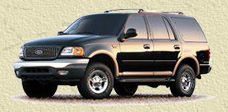


![]()



![]()

Expeditions will have a choice of two Triton V8 engines and two automatic transmissions. The Triton 5.4L V8 is a stroked (and with higher block decks) version of the base 4.6L V8 and comes mated to the E4OD four-speed automatic overdrive. Ford's 4R70W four-speed automatic OD will back the 4.6L Triton. Designed for minimal maintenance, the Tritons have a 100,000-mile tune-up interval and include several idiot-reduction features. Fail-safe cooling allows the engines to run on alternate sets of cylinders for a while following loss of coolant (a more practical application of Cadillac's failed 4-6-8 theory), and standard oil coolers on the 5.4L further improve engine durability. A battery-saver feature keeps the battery from draining if lights are inadvertently left on.
Other priorities were maximizing low-end torque (through such features as longer intake runners) without compromising high-rpm horsepower, primarily for improved towing. Noise and vibration also received a lot of attention, and the components were designed to muffle as much of these side-effects as possible.
In 4x4s models, the Expedition has the Control Trac system with Borg-Warner transfer case. It's somewhat similar to the Explorer's four-wheel-drive system except that Control Trac offers a fourth 4-Hi position that Explorer doesn't. The Expedition's three other 4WD dial positions are 4x2 (rear-wheel drive), AWD (which uses a center axle-disconnect to sense loss of traction and adjust front-to-rear torque biasing, automatically defaulting to RWD under full traction), and 4-Lo. Available axle gearing is 3.31:1 (4x2), 3.55:1 (4.6L 4x4), and 3.73:1 (5.4L 4x4). A rear limited-slip diff is optional with the 3.73 gears.
The Expedition's suspension borrows the short-long arm (SLA) approach from the new F-150. In the rear, the standard suspension is a five-link system with coil springs. Ford also offers an optional load-leveling system to appeal to the towing crowd. Rear air bags are used, and 4x4 Expeditions add front air shocks and automatic ride heights: the air suspension "kneels" down one inch when the key is turned off, raises to normal height/load leveling for normal driving, and lifts up another inch when the transfer case is shifted in 4-Lo. To further improve ride and handling, Expeditions have speed-sensitive steering: more power assist at slow speeds and progressively less assist at faster speeds to minimize over correction.
Ride and drive revealed that the Expedition performs as designed. Overall comfort is superb, making this a serious contender for the ultimate cross-country cruiser. Off-road, the Expedition's suspension seems tuned for secondary, washboard-type roads, and it glided over these like an air-hockey puck.
Obviously, the vehicle isn't designed to traverse the Darian Gap, and ground clearance and suspension travel are set up for the terrain that 99.9% of new-vehicle buyers commonly encounter: pavement and graded dirt. Finally, fit and finish of the Expedition is excellent.
Judging from the success of the Explorer and 1997 F-150, the Expedition appears to be another winner from Ford. Don't mourn the Bronco without driving an Expedition.
Last modified: Thursday December 13, 2007 07:35 AM